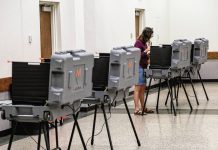A local dentist’s investment in solar energy means the power of the sun will help provide the electricity powering everything from the office lights to the equipment used for dental procedures.
White River Dental employees, as well as Columbus Mayor Jim Lienhoop and three officials from Electro Green Energy Solutions, an Indianapolis-based green energy project development firm, recently gathered in the dentist office training room to hear details about office’s new ambitious investment — 81 solar panels installed on the building’s roof.
Nick Koon, vice president of Electro Green Energy Solutions, who led the presentation, showed some aerial footage of White River Dental’s solar panels on a projector screen. He then opened an internet browser and signed into a “digital kiosk,” which is a monitoring and data analytics platform that tracks the panels’ output.
In a little under a month, according to the digital kiosk, the energy generated by the solar panels at White River Dental had saved 1.5 trees and 1.3 barrels of oil. The solar panels are expected to offset approximately 26 percent of the building’s annual energy use, said Dr. Aaron Strickland, dentist and owner of White River Dental, on Columbus’ west side.
[sc:text-divider text-divider-title=”Story continues below gallery” ]Click here to purchase photos from this gallery
“There’s multiple reasons why we wanted to do this,” Strickland said. “(There are) huge benefits of being a solar panel owner and operator as far as not only helping the environment, but also saving on consumption of energy and doing what we can do to give back to our community. It was an investment that I think is going to be a 10-fold win in multiple different ways. We’re one of the only offices in Columbus and one of the only dental offices in the state of Indiana that has solar panels at this point, and we’re hoping this will set a trend to have other healthcare providers try to change the way we do business and help the environment as well.”
The solar panels, which are not visible unless you are on the roof, cover a 90-foot-by-60-foot portion of the roof’s western side, Koon said. Each panel weighs 51.8 pounds and is 79.3 inches long, 39.4 inches wide and 1.38 inches thick.
The panels sit in casings that are approximately 6 inches above the roof. They all face south to maximize the amount of sunlight they can receive throughout the day, Koon said. The panels were manufactured by Hanwha Q CELLS Co. Ltd., a subsidiary of Hanwha Group, a South Korea-based conglomerate.
The solar panels absorb sunlight to generate electricity. The panels, however, only generate direct current, or DC energy, which is not the form of energy that many appliances use.
A device called an inverter, which also was installed on White River Dental’s roof, then converts the DC energy into alternating current, or AC power, which is the type of power the building runs on.
The panels will generate power, albeit less power, on cloudy days and even with up to four inches of snow on them, said Jerry Strickland, co-director of marketing at White River Dental and father of Dr. Aaron Strickland.
The suction tubes that the dentist uses to suck out saliva from a patient’s mouth and the air compressor for the air drills used for fillings and other procedures are among the equipment that use up the most electricity at the dental office, Jerry Strickland said.
When White River Dental produces more energy than it uses, Duke Energy will issue a credit to the dental office at the same rate that it charges customers to use electricity, Koon said. The panels will continue generating power when the dental office is closed on Sundays.
“When you over-produce, you push (the energy) back to the grid,” Koon said. “With Duke (Energy), they give you a dollar-per-dollar credit for every kilowatt you over-produce.”
After the system was installed at White River Dental, Duke Energy put in a two-way meter to allow White River Dental to send excess energy back to the power grid, said Brian Steinkamp, director of strategy and development at Electro Green Energy Solutions.
“Before the (solar panel) system was here, the meter only spun one way,” Steinkamp said. “After it’s in, they change out the meter so that on Sunday, when (White River Dental) is generating more electricity than they use, the meter actually spins the other way to keep track of the credits we’re sending back to the grid.”
Jerry Strickland said White River Dental spent “in the ballpark of $100,000” to install the solar panels. The warranty from the manufacturer says the panels will produce 80 percent of their original output 20 years after going online, said Koon, who estimates that solar panels will pay for themselves in approximately four to five years.
Even though White River Dental is one of the first medical offices in the Columbus area to install solar panels at its facility, it reflects a growing trend in Indiana and across the country, according to solar power industry analysts. An increasing number of businesses are investing in solar power as the price of the solar panels has decreased and the cost of electricity has increased, according to the Solar Energy Industry Association, an industry trade group.
Last year, non-residential solar installations in Indiana roughly doubled from just over 20 megawatts in capacity installed in 2017 to just under 40 megawatts in 2018, according to the association.
Though Indiana ranks 24 out of 50 states in terms of installed solar power capacity, the Hoosier State has been home to some major solar power projects in recent years, including a 75-acre solar farm with 76,000 solar panels at Indianapolis International Airport, which as of 2014 was the largest airport solar farm in the world.
“The cost to install solar has dropped by more than 70 percent over the last decade, leading the industry to expand into new markets and deploy thousands of systems nationwide,” according to the association. “Prices as of Q4 2018 are at their lowest levels in history across all market segments. An average-sized residential system has dropped from a pre-incentive price of $40,000 in 2010 to roughly $18,000 today.”
Small businesses in Columbus could be especially well-positioned to take advantage of federal tax subsidies and grants that could eliminate up to 55 percent of the costs of installing a solar panel system, Steinkamp said.
The Rural Energy for America Program, or REAP, Grant from the U.S. Department of Agriculture provides small businesses up to 25 percent of the money needed to purchase, install and construct solar power systems, with a maximum award of $500,000 for renewable energy systems, according to the USDA’s website. The grant is only available to companies in rural areas.
Columbus is considered a rural area because its population was under 50,000 people during the previous U.S. census in 2010, Steinkamp said.
To qualify for the grant, a company must be considered a “small business” by the U.S. Small Business Administration’s size standards. The standards vary be industry and also take into consideration the number of employees and the company’s revenue.
Additionally, the federal solar tax credit allows certain companies and individuals to deduct 30 percent of the cost of installing a solar energy system from their federal taxes.
“As the cost of solar have come down dramatically in the last five years, and the price of electricity keeps going up … the 30 percent incentive can really take you over the top and you can get some pretty healthy rates of return over a 25-year life of a system,” Steinkamp said.
“Once Columbus breaks 50,000 (in population), and once the federal tax credit drops off in 2022, a lot of those incentives go away,” he added.
White River Dental has applied for a REAP Grant, but is still awaiting a response from the USDA, Electro Green Energy Solutions officials said.
Lienhoop, who attended the demonstration of the solar panels and took a tour of the dental office, called White River Dental’s investment in solar power a “tremendous commitment to the community.”
“It’s a tremendous commitment to the community and to — I don’t know if you would call it the green movement — but just the whole notion of having a more environmentally-friendly place to do business,” Lienhoop said. “I think that’s always much appreciated. In a community like this, we’re always looking for people to lead. We’re looking for someone to take that step out and say, ‘Here, look at what we did,’ and if we can get some copycats, I’m sure Dr. Strickland will appreciate that, and I certainly will, too.”
[sc:pullout-title pullout-title=”To learn more” ][sc:pullout-text-begin]
For more information about White River Dental in Columbus, visit wrdental.com.
[sc:pullout-text-end]




